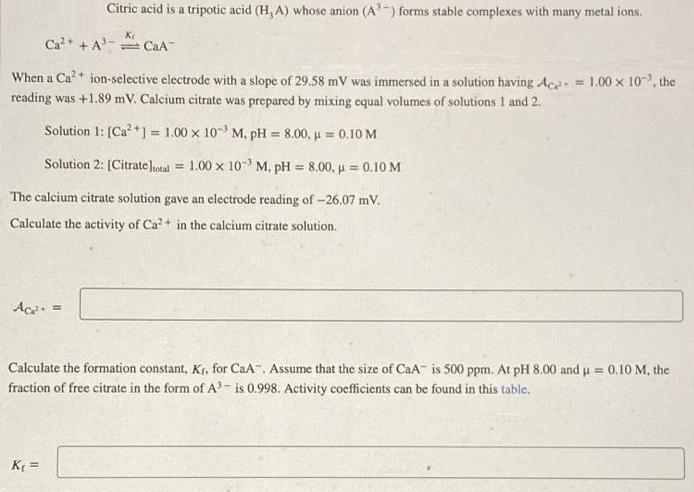Answered step by step
Verified Expert Solution
Question
1 Approved Answer
Citric acid is a tripotic acid (H, A) whose anion (A-) forms stable complexes with many metal ions. Ca + A- = CaA When

Citric acid is a tripotic acid (H, A) whose anion (A-) forms stable complexes with many metal ions. Ca + A- = CaA When a Ca* ion-selective electrode with a slope of 29.58 mV was immersed in a solution having Ace = 1.00 x 10, the reading was +1.89 mV. Calcium citrate was prepared by mixing equal volumes of solutions 1 and 2. Solution 1: [Ca*] = 1,00 x 10 M, pH = 8.00, u = 0.10 M Solution 2: [Citratelotal = 1.00 x 10 M. pH = 8.00, u = 0.10 M %3D The calcium citrate solution gave an electrode reading of -26.07 mV. Calculate the activity of Ca?+ in the calcium citrate solution. Aca = Calculate the formation constant, Kr. for CaA". Assume that the size of CaA- is 500 ppm. At pH 8.00 and u = 0.10 M, the %3D fraction of free citrate in the form of A3- is 0.998. Activity coefficients can be found in this table. K =
Step by Step Solution
★★★★★
3.43 Rating (175 Votes )
There are 3 Steps involved in it
Step: 1
Like Cl2 CHCO from table the activity CoEfficient for this type O...
Get Instant Access to Expert-Tailored Solutions
See step-by-step solutions with expert insights and AI powered tools for academic success
Step: 2

Step: 3

Ace Your Homework with AI
Get the answers you need in no time with our AI-driven, step-by-step assistance
Get Started


